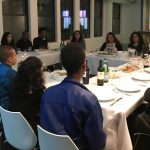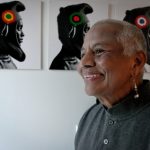Fiscal Sponsorship / Fellows at 30: Karen Marshall
“For me it’s always about process: developing projects, establishing vision, and moving from intent to edit…making art is a conversation with yourself, otherwise you’re going to get bored!”
New York photographer Karen Marshall (Fellow in Photography ‘90) documents social issues. By focusing on the psychological lives of her subjects, she has worked on a series of visual stories that contemplate familial relationships and convey ideas about people and place within the cultural landscape. Marshall’s Fiscally Sponsored Project, Between Girls: A Passage To Womanhood, is a seminal study that articulates the coming of age of a group of urban middle class teenagers, following them from high school into adulthood 30 years later.
Marshall’s interest in establishing new frameworks for the documentary genre has led her to create an exhibition based on this project that uses traditional black and white photographs, bookmaking, and video and audio in conjunction with community programing.
If you’re local to Orlando, or are in town for the Society of Photographic Education National Conference, you can hear Karen’s Between Girls lecture on March 11, 2017 at the Conference:
What: “Between Girls: A Passage To Womanhood. The Creation of A Thirty-Year Project,” a lecture by Karen Marshall
When: March 11, 2017, 10:00 AM – 10:45 AM
Where: Orange AB, Hilton Orlando, 6001 Destination Parkway, Orlando, FL 32819
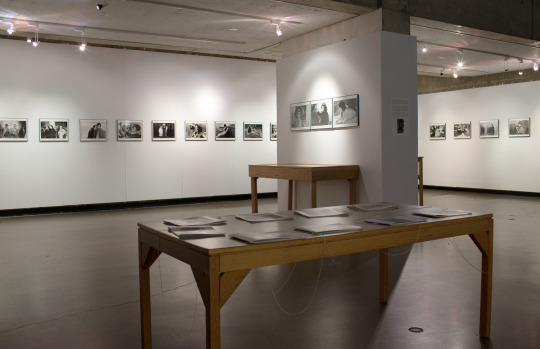
NYFA: How did your Fiscally Sponsored Project, Between Girls: A Passage to Womanhood 1985-2015, begin? What catalysts prompted the transitions from silver print photographs to a documentary film to a new media installation?
Karen Marshall: I began taking pictures when I was 13. By 1985 I had been shooting on the street for a decade, and I wanted to do something different. I wanted to get inside peoples’ lives, both physically (off the street), but also psychologically, and I decided to make a documentary photo essay about teenage girls’ relationships with one another.
I came of age during the women’s consciousness movement in the 1970’s, yet by the 1980’s no one was talking about feminism. I wanted to observe teenage girls and look at what the girl world was all about. Right from the start, I sought out middle class girls who went to public high school. I wanted this project to talk specifically about friendship between girls, and so often essays about New York City kids focused on children under the poverty line or the super wealthy and that was not my intention.
Through a friend, I met 16-year-old Molly, and she introduced me to her group of friends. Molly really got what I was interested in. All of the girls I photographed went to The Bronx High School of Science or Fiorello H. LaGuardia High School of Music & Art and Performing Arts and were just beginning their junior years. I photographed them intensively for ten months and then tragically, Molly got hit by a car while on vacation and was killed. Everything changed. I realized that Molly would remain seventeen and the rest of them would become women, and I knew I had to continue photographing. It was hard to photograph the girls during their senior year but I did.
At this point, I shopped Between Girls around as a book project. But the text just didn’t match the power of the images. When the women were twenty I invited some of them into a recording studio to talk about this time in their lives. I created a 12.5 minute audio piece, which is really poignant. I now had a slidetape show presentation and considered taking the still images and the audio and making them into a film, but that proved to be too expensive at that time when technology was just beginning to develop. I continued photographing them, recorded more audio with a Sony Walkman pro, and shot some video when camcorders became cheap. A few times over the years I brought the women together as a group and had other people shoot video, first in Hi8, later in DigiCam and even later in Digi Beta.
By the late 1990’s and early 2000’s, I had amassed hundreds of rolls of black and white 35mm film, audio recordings on reel-to-reel tape and cassette, and video shot in many different forms and qualities. Ha. What’s great about this project is that you can see the evolution of technology in the media through the project itself. Over time these changes become part of the project. My ‘Aha!’ moment came in realizing that these different pieces of media were in fact part of the project.
The photographs are still the center of everything in the complete version of Between Girls that I exhibited at Hampshire College last year. In essence, the work is as much about photography and how visual storytelling has evolved into new media as it is about the relationship of a group of women. Many of my friends and fellow artists are interested in new media as it exists on the web, but I’m really drawn to the physicality of the photograph in relation to media. I’m focused on the installation itself and the curation of my own media artifacts and how these became part of narrative. Someone told me that Between Girls is like reading a really good novel because you reference your own life in the narrative. I don’t know if you can experience this project fully on a screen or website. Everything is an extension of the next. In my life as an artist and in my life as a teacher and mentor, I love to put images and ideas together. Sometimes they are mine and sometimes they are someone else’s, it’s all the same process.
I don’t know where it’s going next but the project is happening. I think it’s a really wonderful piece for a university museum because it’s interdisciplinary. Between Girls is not just for those interested in photography; it can instigate discussion for those thinking about behavioral psychology, writing, and gender studies. It’s in essence a community piece. I think it has the potential to inspire conversation and I can see various ways that women from a senior center or teenagers from a high school could interact with it. You could use this exhibition as a jumping off point for a workshop on storytelling. I have started writing a curriculum with an educator for teenagers. I’m hoping that the project can also become about other people’s work. But we’ll see.

NYFA: In October 2015, Between Girls: A Passage to Womanhood 1985-2015, was exhibited at Hampshire College. How did this project arrive there and what is next for its life?
KM: My project is now thirty years old. It started in 1985. I originally thought I was making a film when I applied for fiscal sponsorship to help fundraise for it. Once I had some funding and began editing, I was like, ‘Eww…I’m a photographer.’ So in 2006, when I made a trailer for a film, I realized that it was absolutely not where I wanted the work to go. That failure was a wonderful gift. By 2007 I became committed to formatting Between Girls as a new media project for the gallery setting.
In the fall of 2015 I showed the completed Between Girls: A Passage To Womanhood in full at Hampshire College. Over the years I had exhibited bits of the work at various venues, so it was great to finally see the whole project exhibited at one venue. Plus, now I have documentation of the entire project, which I never had before. I can actually show people what the project looks like installed, which of course is especially helpful for getting it seen in new venues. I still have a few things I want to tweak and although I raised $10,000 for this project; reflecting back, I should have raised $15,000. In the future, perhaps there will be a book. The desire to make a book of this work has always been there. Although, even if I find the right publisher, I will still need to raise more money. Lots of money.
NYFA: You received a NYSCA/NYFA Artist Fellowship in 1990 for the project Caretakers of the Earth: Navajo Resistance and Relocation. How did you find this subject and where does this project stand today? Do you remember what you did with the fellowship funding?
KM: In the mid-late 1980’s, as I watched fellow photographers go off to South Africa and Latin America to photograph indigenous peoples and their struggles, I thought, ‘What about indigenous people in the U.S.?’ So I started to investigate this subject and got an assignment in New Mexico to take pictures for a magazine. I had heard about a group of 11,000 Navajo Indians in Arizona who had been forced to relocate from ancestral land when the U.S. government changed reservation boundaries. I contacted some lawyers representing the affected Navajo and they in turn introduced me to some of the Navajo families. I was granted permission to tell their story ‘to the outside world.’ During my time in the Southwest I also took some color landscapes that I sold to people furnishing doctors’ offices and such. These pictures funded the project along with the Fellowship. I used my $7,000 for printing, paper, and darkroom costs. The Fellowship also funded a couple of trips out there. The money went far. Farther than it would have today. I remember the year after, a friend of mine received a Fellowship and bought a camera. For me, the Fellowship award was about the maintenance of my practice.
I worked on the Navajo project for about ten years, from around 1987 to 1997. I had exhibitions and gave lectures on the work, but I really regret not having been able to publish a book of these photographs at the time. It was a controversial subject and that proved difficult, plus I ran out of money and I had by then become a mother. As it stands now, I still believe this work should be published in book form, it is important visual history. Life on the reservation is still a pressing issue and additional fundraising is needed to continue the project.
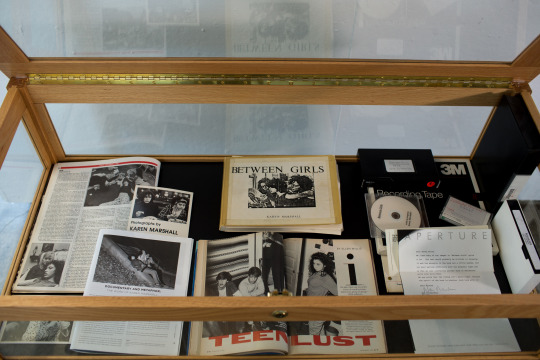
NYFA: How do you develop your practice?
KM: Process is extremely important to me. I’m concerned about the product- driven element of the art world today. Artists (who are not necessarily superficial) are making such product-driven work just to get [representation by] a gallery and become well known. It’s not a diss on them. What are we as artists to do? I am an unrealistic dreamer.
For me, it’s always about process: developing projects, establishing vision, and moving from intent to edit. It’s really important to have a goal and to figure out how to frame your work. In essence, making art is a conversation with yourself, otherwise you’re going to get bored! I had to accept the fact that my work is about a long-term trajectory.
Photography is about a fraction of a second or a fraction of a story that builds over time. Documentary inquiry is about telling stories and that’s why I take images. I do sometimes think, ‘Can this project please just go to college for a bit? Can Between Girls take care of itself and just come visit me?’ Maybe it’s actually good to have a project and finish it, but that hasn’t happened to me just yet.
NYFA: Why did you choose NYFA Fiscal Sponsorship, as opposed to a sponsor that focuses on film?
KM: I really felt that it was important to get sponsorship from a place that supported artists in all disciplines. NYFA’s Fiscal Sponsorship model allows for evolution. Remember, when I started the project I thought it was going to be a film and when I completed the project it was something different. NYFA [also] gave me credit with funders outside the art world.
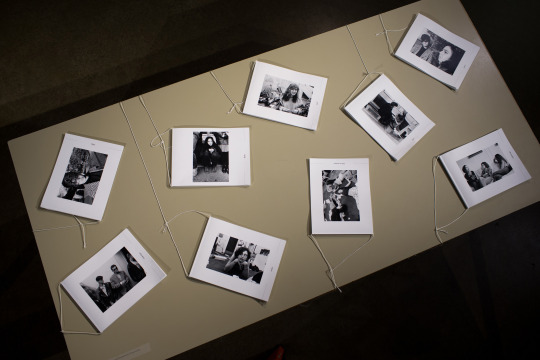
NYFA: Your relationship with NYFA began in 1990 with the NYSCA/NYFA Artist Fellowship in Photography. In 1999, you were accepted into the Fiscal Sponsorship program for Between Girls, and your participation in the program continues through the project’s next phase. What has your relationship with NYFA been like over the years?
KM: Yes, NYFA has been part of my life for the past 26 years. I was even hired to take photos for NYFA events ages ago! I think they were for a program called “Artists in Schools” that NYFA sponsored all over the state. I also participated in an exhibition NYFA produced with Tanqueray Gin. NYFA curated it, and each artist received a couple of thousand dollars to create work for the exhibition. NYFA brought together this diverse group of photographers for an exhibition that in turn was sponsored by Tanqueray.
I deeply appreciate NYFA’s support of my work throughout all these years. They have validated who I am as an artist, and so much of my work would not have been possible without their ongoing support! At a time in the U.S. when there is so little funding for the arts, it has been comforting to have them as a consistent presence in my life.
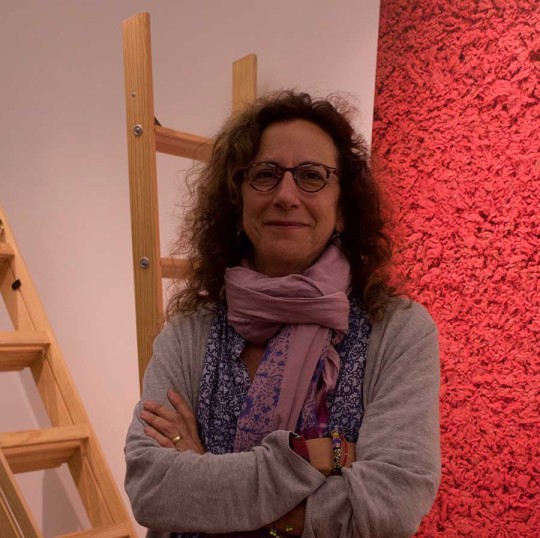
NYFA: What’s next for you?
KM: At the moment I mainly shoot in medium format color film and I’m currently developing a project about the places in Poland from which my grandparents emigrated in the 1920’s and never returned. The tentative title is Still, Standing. I also have a number of other projects up my sleeve and I have never stopped shooting on the streets. A lot of what I’ve been photographing is not of people, but as usual is totally about people.
Are you interested in using NYFA Fiscal Sponsorship to support your next great idea? Check out more details here. March 31 is our next quarterly application deadline. And be sure to follow the work of past and present NYFA affiliated artists on Facebook, Twitter, and Instagram.
– Interview conducted by Madeleine Cutrona, Program Officer, Fiscal Sponsorship and Madeline Scholl, Program Officer, Grants & Exhibitions
Images, from Top: All installation images courtesy of the artist and from an October 2015 Installation at Hampshire College; Collage detail From 8′ x 4.5′ collage made of 30 Years of Xerox’s from The Project Archive|View of part of the installation. Foreground: 9 unique zines sit on a table, each containing aspects of the 30-Year Archive. Silver gelatin prints of the original images made when the Between Girls subjects were teenagers, Vitrine holding Molly’s diary and other writings, a triptych of Molly when she was 16, on her 17th birthday, and a week before she was killed|Three Channel Video Projection|Detail of Project Ephemera Vitrine|Detail of the 9 unique zines that contain aspects of the 30-Year Archive|Image of artist, 2016. Photo by NYFA.


